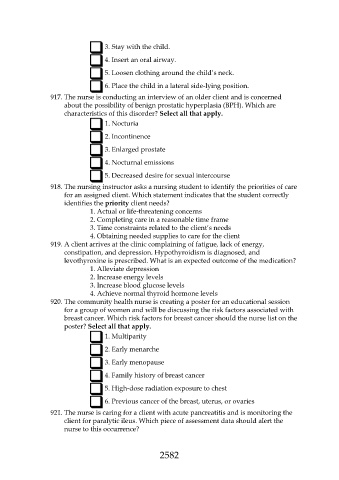Page 2582 - Saunders Comprehensive Review For NCLEX-RN
P. 2582
3. Stay with the child.
4. Insert an oral airway.
5. Loosen clothing around the child’s neck.
6. Place the child in a lateral side-lying position.
917. The nurse is conducting an interview of an older client and is concerned
about the possibility of benign prostatic hyperplasia (BPH). Which are
characteristics of this disorder? Select all that apply.
1. Nocturia
2. Incontinence
3. Enlarged prostate
4. Nocturnal emissions
5. Decreased desire for sexual intercourse
918. The nursing instructor asks a nursing student to identify the priorities of care
for an assigned client. Which statement indicates that the student correctly
identifies the priority client needs?
1. Actual or life-threatening concerns
2. Completing care in a reasonable time frame
3. Time constraints related to the client’s needs
4. Obtaining needed supplies to care for the client
919. A client arrives at the clinic complaining of fatigue, lack of energy,
constipation, and depression. Hypothyroidism is diagnosed, and
levothyroxine is prescribed. What is an expected outcome of the medication?
1. Alleviate depression
2. Increase energy levels
3. Increase blood glucose levels
4. Achieve normal thyroid hormone levels
920. The community health nurse is creating a poster for an educational session
for a group of women and will be discussing the risk factors associated with
breast cancer. Which risk factors for breast cancer should the nurse list on the
poster? Select all that apply.
1. Multiparity
2. Early menarche
3. Early menopause
4. Family history of breast cancer
5. High-dose radiation exposure to chest
6. Previous cancer of the breast, uterus, or ovaries
921. The nurse is caring for a client with acute pancreatitis and is monitoring the
client for paralytic ileus. Which piece of assessment data should alert the
nurse to this occurrence?
2582

